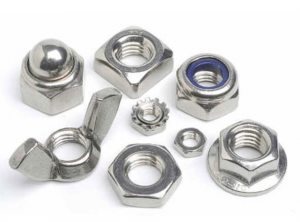
 First, let’s have a quick refresher on the unique fastening ability of nuts and bolts. As we all know, a nut is a fastener featuring a threaded hole and is always used with a mating bolt to fasten a stack of parts together. The two components are held together by a combination of thread friction, a slight expansion of the bolt, and compression of the parts. In applications where vibration or rotation may cause the components to loosen, adhesives, split pins, and other techniques are used to prevent fastener rotation. The most common nut shape is hexagonal, primarily because nuts need to have parallel sides to accommodate a wrench laterally but also because you generally have limited room with which to work with a wrench so more parallel sides provide more options for wrench placement and require less rotating room.
First, let’s have a quick refresher on the unique fastening ability of nuts and bolts. As we all know, a nut is a fastener featuring a threaded hole and is always used with a mating bolt to fasten a stack of parts together. The two components are held together by a combination of thread friction, a slight expansion of the bolt, and compression of the parts. In applications where vibration or rotation may cause the components to loosen, adhesives, split pins, and other techniques are used to prevent fastener rotation. The most common nut shape is hexagonal, primarily because nuts need to have parallel sides to accommodate a wrench laterally but also because you generally have limited room with which to work with a wrench so more parallel sides provide more options for wrench placement and require less rotating room.
Specialized nut shapes exist for specific needs, so let’s take a closer look at the other two main nut shapes:
Acorn nuts, also known as cap nuts, feature a rounded, dome end on one side that gives the component a more finished look. They are typically made with brass, steel, stainless steel, or nylon and come with either a standard dome or high dome to protect extra-long bolts. Acorn nuts can be self-locking to prevent them from vibrating loose.
Wing nuts are ideally suited for applications that require the nut to be easily removed with tools. They feature two pronounced “wings” or opposing tabs that enable them to be finger tightened or loosened. Because wing nuts are used frequently in marine applications where their ease-of-use is preferred in environmentally-harsh conditions, they are typically made with corrosion-resistant zinc-plated steel or stainless steel.
Of course, we’ve just scratched the surface of nuts (and bolts) in the fastener world. To learn more about the various shapes, sizes, and materials used in common and unique nut-and-bolt combinations, contact the nuts-and-bolts specialists here at Electronic Fasteners.

